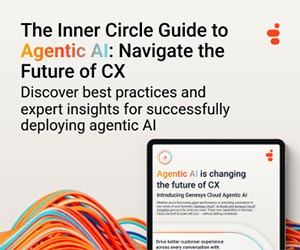Calabrio look at how the contact centre landscape is evolving at an unprecedented pace-and AI is at the centre of it all.
However, ask most contact centre leaders and they’ll tell likely you that the industry isn’t changing just because AI is transforming the way contact centres work and interact with customers-it’s evolving because it has to.
Customers continue to expect more-more speed, more convenience, more channels-and expect businesses to deliver seamless, high-quality experiences.
Organizations in search of ways to meet these demands are also looking to contact centre AI to play a critical role in reducing strain on agents, driving increased productivity and efficiency, and elevating customer experiences.
In fact, according to our recent survey of global CX leaders, 98% of contact centres are already using AI. How exactly are contact centres using AI, though? And how successful are their current AI strategies? What else does the future hold? Find out in the guide below.
The AI Imperative in Today’s Contact Centres
As customer expectations keep rising, traditional contact centre strategies, workflows, and tools are struggling to keep up:
- According to 61% of contact centre leaders, customer interactions have only gotten more difficult and emotionally charged in the past year.
- 40% of leaders cite growing customer demand for 24/7, always-on support
- 36% say demand for faster, more personalized interactions also continues to increase
When consumers have more options than ever – and most organizations are now primarily competing on customer experience – the stakes of satisfying customers’ needs couldn’t be higher.
Yet, in the face of these sky-high expectations, contact centres too often rely on manual processes, like reviewing a small fraction of calls for quality assurance.
Manual workflows frequently leave decision-makers and agents alike with incomplete or insufficient insights, inconsistent evaluations, and delayed feedback – leading to disconnected contact centre customer experiences and fuelling frustration.
How Leaders Think AI Can Improve Contact Centre Performance & CX
The current situation is hard on customers and the bottom line—and potentially even harder on frontline agents themselves. In short, it’s unsustainable. And leaders are looking to AI to provide a variety of answers.
According to our State of the Contact Center report, they’re optimistic about contact center AI’s potential to help usher in a new era of customer service:
- 83% of leaders believe AI will enable 24/7 omnichannel customer support
- 79% believe it will transform the contact centre from a cost centre to a strategic value driver
- 78% say it will transform contact centres into predictive engagement hubs
- 73% agree it will unlock deeper customer insights, enabling contact centres to anticipate needs and deliver hyper-personalized experiences.
Top Contact Centre AI Trends & Use Cases
Of course, with all this optimism comes an important question: How will AI achieve all this?
Let’s look at the top uses of AI in the contact centre and the key benefits they can deliver.
Chatbots & Voicebots for AI-Driven Self-Service
Leveraging conversational AI and Natural Language Processing (NLP), intelligent chatbots and voicebots are transforming self-service.
These tools can understand customer intent, handle increasingly complex queries 24/7, automate routine tasks (like checking balances or updating information), and provide instant answers. Crucially, they can also ensure seamless, context-aware handoffs to human agents when needed.
Benefits: Improves self-service containment rates, reduces agent workload for simple/repetitive tasks, offers immediate support anytime, lowers operational costs, and enhances customer convenience.
AI-Powered, Automated Quality Management
Manual quality assurance, typically covering only 1-3% of interactions, is being revolutionized by automated quality management.
AI analyses potentially 100% of interactions (calls, chats, emails) against customizable scorecards, providing objective, consistent evaluation at scale.
This identifies coaching opportunities and ensures compliance adherence far more comprehensively than manual methods.
Benefits: Dramatically increases QA efficiency and coverage, eliminates human scoring bias, enables faster agent feedback loops, allows QA teams to focus on strategic coaching, and reduces compliance risk.
GenAI Conversation Intelligence, Sentiment Analysis, & Speech Analytics
AI dives deep into the content and context of customer interactions. Speech analytics transcribes calls, while text analytics processes digital channels.
Advanced AI, including Generative AI, then analyses this data to uncover sentiment trends, gauge customer emotion and effort, identify trending topics, summarize interactions, and pinpoint root causes of issues or satisfaction drivers across all conversations.
Benefits: Provides a true understanding of the Voice of the Customer, identifies friction points and areas for process improvement, uncovers targeted coaching needs, ensures compliance, and extracts valuable business intelligence from unstructured interaction data.
Predictive Analytics & Reporting
AI excels at identifying patterns in historical data to forecast future events. In the contact centre, predictive analytics can help teams more accurately forecast interaction volumes for better staffing and scheduling, predict customer churn risk or likelihood to purchase, anticipate reasons for contact, and identify interactions most likely to require quality review or supervisor attention.
This fuels more insightful reporting and proactive strategies.
Benefits: Improves workforce scheduling accuracy, enables proactive customer retention efforts, optimizes resource allocation, helps anticipate and mitigate potential service issues, and provides forward-looking insights for strategic planning.
AI Call Routing
Moving beyond basic skills-based routing, AI-powered routing directs incoming interactions based on a multitude of factors analysed in real-time.
This can include predicted customer intent, past interaction history, sentiment analysis, agent performance data, and predicted best agent match to maximize the chance of a successful outcome (like FCR or high CSAT).
Benefits: Improves FCR, enhances customer satisfaction by matching customers with the best-suited agent, optimizes agent utilization, and reduces transfer rates and handle times.
Agent Assistance
Agent assist AI solutions act as a real-time co-pilot for agents during live interactions. They listen to or read the conversation and automatically provide contextual support, such as surfacing relevant knowledge base articles, suggesting next-best actions or responses, providing compliance reminders, and automating post-interaction summaries or data entry tasks.
Benefits: Reduces agent cognitive load, decreases Average Handle Time (AHT), improves consistency and compliance, boosts agent confidence and performance, and allows agents to focus more on building rapport and complex problem-solving.
Preparing for the Future: How to Embrace Contact Centre AI that Empowers Agents and Customers
The future of contact centres and customer service is undeniably intertwined with AI, but it’s crucial to approach implementation strategically. To unlock the full potential of contact centre AI:
Human + AI Synergy
The goal isn’t to replace humans but to augment their capabilities. Focus on AI tools that empower agents, reduce their cognitive load, and enable them to perform at their best.
Strategy & Change Management
Successful AI adoption requires a clear vision, well-defined goals, clean data, and effective change management to ensure agent buy-in and smooth integration into workflows.
According to the State of the Contact Centre 2025 report, 59% of contact centres currently fail to provide ongoing coaching and support to help agents navigate AI-driven workflows.
Providing hands-on support will be key to building trust, increasing adoption, and delivering results now and as future innovations continue to emerge.
Ethical Considerations
71% of contact centre leaders anticipate AI adoption will be limited by ethical concerns, data privacy issues, and regulatory challenges.
Develop a comprehensive strategy now to implement AI responsibly. And, crucially, work only with partners a demonstrated commitment to doing the same.
This blog post has been re-published by kind permission of Calabrio – View the Original Article
For more information about Calabrio - visit the Calabrio Website
Call Centre Helper is not responsible for the content of these guest blog posts. The opinions expressed in this article are those of the author, and do not necessarily reflect those of Call Centre Helper.
Author: Calabrio
Reviewed by: Jo Robinson
Published On: 17th Jun 2025 - Last modified: 24th Jun 2025
Read more about - Guest Blogs, Calabrio






 The digital foundation of a customer-centric contact centre, the Calabrio ONE workforce performance suite helps enrich and understand human interactions, empowering contact centres as a brand guardian. Calabrio ONE unites workforce optimisation (WFO), agent engagement, and business intelligence solutions into a cloud-native, fully integrated suite.
The digital foundation of a customer-centric contact centre, the Calabrio ONE workforce performance suite helps enrich and understand human interactions, empowering contact centres as a brand guardian. Calabrio ONE unites workforce optimisation (WFO), agent engagement, and business intelligence solutions into a cloud-native, fully integrated suite. 





























